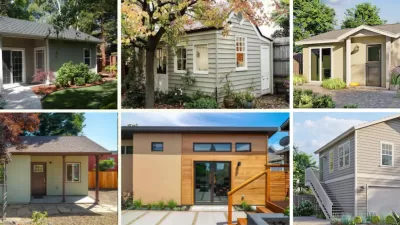The San Francisco Board of Supervisors has approved legislation that will allow the construction of accessory dwelling units, potentially adding thousands of units to the city's housing supply.
"Grappling with a housing shortage that has sent rents soaring 50% since the recession, city officials on Tuesday passed legislation allowing landlords to carve fresh apartments out of underutilized spaces, including storage areas and utility rooms," reports Laura Kusisto [paywall].
"The measure allows for buildings with fewer than five units to add one apartment and larger buildings to add unlimited units. City planners estimate that could add some 14,000 units to the city’s housing stock," adds Kusisto.
Kusisto adds one detail that distinguishes the new accessory dwelling unit legislation in San Francisco from other examples around the country: "San Francisco’s legislation is unusual in that it is designed to encourage the creation of units within apartment buildings as well as in single-family houses."
Joshua Sabatini also covers the new legislation in a separate article. Sabatini focuses specifically on a political compromise that paved the way for the legislation. Another important detail that was necessary for the approval of the legislation accessory dwelling units can "only be created within existing structures in place for at least three years or in the open spaces under decks or lightwell infills if the structures existed prior to July 11." The legislation stops short of allowing ADUs in the buildable area of properties.
FULL STORY: Supervisors reach compromise to allow in-law units across SF

Trump Administration Could Effectively End Housing Voucher Program
Federal officials are eyeing major cuts to the Section 8 program that helps millions of low-income households pay rent.

Planetizen Federal Action Tracker
A weekly monitor of how Trump’s orders and actions are impacting planners and planning in America.

The 120 Year Old Tiny Home Villages That Sheltered San Francisco’s Earthquake Refugees
More than a century ago, San Francisco mobilized to house thousands of residents displaced by the 1906 earthquake. Could their strategy offer a model for the present?

HSR Reaches Key Settlement in Northern California City
The state’s high-speed rail authority reached an agreement with Millbrae, a key city on the train’s proposed route to San Francisco.

Washington State Legislature Passes Parking Reform Bill
A bill that would limit parking requirements for new developments is headed to the governor’s desk.

Missouri Law Would Ban Protections for Housing Voucher Users
A state law seeks to overturn source-of-income discrimination bans passed by several Missouri cities.
Urban Design for Planners 1: Software Tools
This six-course series explores essential urban design concepts using open source software and equips planners with the tools they need to participate fully in the urban design process.
Planning for Universal Design
Learn the tools for implementing Universal Design in planning regulations.
Ada County Highway District
Clanton & Associates, Inc.
Jessamine County Fiscal Court
Institute for Housing and Urban Development Studies (IHS)
City of Grandview
Harvard GSD Executive Education
Toledo-Lucas County Plan Commissions
Salt Lake City
NYU Wagner Graduate School of Public Service





























